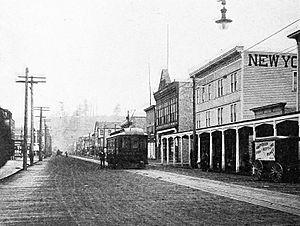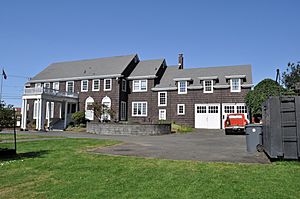Hoquiam, Washington facts for kids
Quick facts for kids
Hoquiam, Washington
|
|
|---|---|
| City of Hoquiam | |
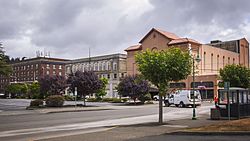
Downtown Hoquiam
|
|
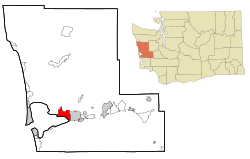
Location of Hoquiam, Washington
|
|
| Country | United States |
| State | Washington |
| County | Grays Harbor |
| Established | 1867 |
| Incorporated | May 21, 1890 |
| Area | |
| • City | 16.42 sq mi (42.54 km2) |
| • Land | 9.54 sq mi (24.72 km2) |
| • Water | 6.88 sq mi (17.82 km2) |
| Elevation | 20 ft (6 m) |
| Population
(2020)
|
|
| • City | 8,776 |
| • Estimate
(2022)
|
8,798 |
| • Density | 906.85/sq mi (350.15/km2) |
| • Metro | 77,038 |
| Time zone | UTC-8 (Pacific (PST)) |
| • Summer (DST) | UTC-7 (PDT) |
| ZIP code |
98550
|
| Area code(s) | 360 |
| FIPS code | 53-32300 |
| GNIS feature ID | 1512309 |
Hoquiam (say it: HOH-kwee-um) is a city in Grays Harbor County, Washington, USA. It's right next to the city of Aberdeen, sharing a border at Myrtle Street.
Both cities have a history of working with wood and exporting it. Hoquiam has kept its own unique identity. It also has a friendly rivalry with its bigger neighbor, especially in high school sports.
Hoquiam became an official city on May 21, 1890. Its name comes from a Native American word that means "hungry for wood." This name was chosen because of the large amount of driftwood found at the mouth of the Hoquiam River. In 2020, about 8,776 people lived there.
Contents
Hoquiam's History
Early Logging and Mills
One of the first logging businesses in Hoquiam started in 1872. It was set up by a person named Ed Campbell.
About ten years later, Captain Asa M. Simpson helped start the Northwestern Mill. He was a businessman from San Francisco who worked in the lumber industry. In 1881, Captain Simpson sent his manager, George Emerson, to Hoquiam. George Emerson bought 300 acres of land for the new mill. By September 1882, the Simpson mill was making its first wood products.
In 1886, Captain Simpson combined his mill with another one called the Miller Brothers mill. This new company was named the Northwest Lumber Company. Later, it was renamed the Simpson Lumber Company. In 1913, Frank J. Shields became the new manager of the mill in Hoquiam.
Railroads and Paper Mills
The railroad was extended from Aberdeen to Hoquiam starting in 1898. This helped logging and lumber stay important to Hoquiam's economy. In 1927, a pulp mill was built and named Grays Harbor Pulp Company. A year later, a company from Pennsylvania, the Hammermill Paper Company, became interested.
When Hammermill bought shares in Grays Harbor Pulp Company, the Grays Harbor Pulp Company built a paper mill. It then became the Grays Harbor Pulp & Paper Company. In 1936, this company joined with Rayonier Incorporated. Rayonier made a special kind of wood pulp used to create rayon fabric.
In 1907, Hoquiam was also home to a workers' union group called Industrial Union No. 276.
Geography and Climate
City Area
The city of Hoquiam covers about 15.60 square miles (40.40 square kilometers). Most of this area, about 9.02 square miles (23.36 square kilometers), is land. The rest, about 6.58 square miles (17.04 square kilometers), is water.
Local Climate
Hoquiam has a climate that is like a Mediterranean climate. This means it has mild, wet winters and warm, dry summers. It's also very close to an oceanic climate. Outside of the summer, it rains a lot. Sometimes, more than 20 inches (500 mm) of rain can fall in one month.
Snowfall is rare in Hoquiam. Some years, it doesn't snow at all. However, in the winter of 1964-1965, over 40 inches (1 meter) of snow fell during two big storms.
| Climate data for Hoquiam, Washington (Bowerman Airport), 1991–2020 normals, extremes 1953–present | |||||||||||||
|---|---|---|---|---|---|---|---|---|---|---|---|---|---|
| Month | Jan | Feb | Mar | Apr | May | Jun | Jul | Aug | Sep | Oct | Nov | Dec | Year |
| Record high °F (°C) | 63 (17) |
72 (22) |
79 (26) |
86 (30) |
91 (33) |
101 (38) |
93 (34) |
95 (35) |
93 (34) |
83 (28) |
70 (21) |
72 (22) |
101 (38) |
| Mean maximum °F (°C) | 55.9 (13.3) |
59.4 (15.2) |
65.5 (18.6) |
71.9 (22.2) |
77.6 (25.3) |
79.0 (26.1) |
81.9 (27.7) |
84.2 (29.0) |
82.3 (27.9) |
72.7 (22.6) |
60.2 (15.7) |
55.0 (12.8) |
88.3 (31.3) |
| Mean daily maximum °F (°C) | 47.5 (8.6) |
49.6 (9.8) |
52.2 (11.2) |
55.6 (13.1) |
60.1 (15.6) |
63.4 (17.4) |
67.1 (19.5) |
68.1 (20.1) |
67.0 (19.4) |
59.5 (15.3) |
51.6 (10.9) |
46.7 (8.2) |
57.4 (14.1) |
| Daily mean °F (°C) | 42.8 (6.0) |
43.6 (6.4) |
45.8 (7.7) |
48.7 (9.3) |
53.4 (11.9) |
57.1 (13.9) |
60.3 (15.7) |
61.0 (16.1) |
59.1 (15.1) |
52.5 (11.4) |
45.9 (7.7) |
42.0 (5.6) |
51.0 (10.6) |
| Mean daily minimum °F (°C) | 38.0 (3.3) |
37.6 (3.1) |
39.3 (4.1) |
41.9 (5.5) |
46.6 (8.1) |
50.8 (10.4) |
53.7 (12.1) |
53.9 (12.2) |
51.2 (10.7) |
45.5 (7.5) |
40.3 (4.6) |
37.3 (2.9) |
44.7 (7.0) |
| Mean minimum °F (°C) | 27.8 (−2.3) |
27.8 (−2.3) |
30.4 (−0.9) |
32.8 (0.4) |
37.1 (2.8) |
43.4 (6.3) |
47.4 (8.6) |
47.1 (8.4) |
42.7 (5.9) |
34.2 (1.2) |
29.7 (−1.3) |
27.3 (−2.6) |
23.7 (−4.6) |
| Record low °F (°C) | 16 (−9) |
13 (−11) |
22 (−6) |
27 (−3) |
29 (−2) |
36 (2) |
35 (2) |
40 (4) |
32 (0) |
27 (−3) |
12 (−11) |
9 (−13) |
9 (−13) |
| Average precipitation inches (mm) | 10.91 (277) |
6.65 (169) |
7.74 (197) |
5.35 (136) |
2.99 (76) |
2.01 (51) |
0.85 (22) |
1.35 (34) |
2.53 (64) |
6.91 (176) |
10.95 (278) |
10.52 (267) |
68.76 (1,747) |
| Average snowfall inches (cm) | 1.3 (3.3) |
0.8 (2.0) |
trace | trace | 0.0 (0.0) |
0.0 (0.0) |
0.0 (0.0) |
0.0 (0.0) |
0.0 (0.0) |
0.0 (0.0) |
0.4 (1.0) |
0.4 (1.0) |
2.9 (7.3) |
| Average precipitation days (≥ 0.01 in) | 21.8 | 18.4 | 21.5 | 18.9 | 14.0 | 12.0 | 6.0 | 7.1 | 10.0 | 16.9 | 21.6 | 21.9 | 190.1 |
| Average snowy days (≥ 0.1 in) | 0.9 | 0.4 | 0.0 | 0.1 | 0.0 | 0.0 | 0.0 | 0.0 | 0.0 | 0.0 | 0.3 | 0.5 | 2.2 |
| Source 1: NOAA (snow/snow days 1981–2010) | |||||||||||||
| Source 2: National Weather Service | |||||||||||||
Population of Hoquiam
| Historical population | |||
|---|---|---|---|
| Census | Pop. | %± | |
| 1890 | 1,302 | — | |
| 1900 | 2,608 | 100.3% | |
| 1910 | 8,171 | 213.3% | |
| 1920 | 10,058 | 23.1% | |
| 1930 | 12,766 | 26.9% | |
| 1940 | 10,835 | −15.1% | |
| 1950 | 11,123 | 2.7% | |
| 1960 | 10,762 | −3.2% | |
| 1970 | 10,466 | −2.8% | |
| 1980 | 9,719 | −7.1% | |
| 1990 | 8,972 | −7.7% | |
| 2000 | 9,097 | 1.4% | |
| 2010 | 8,726 | −4.1% | |
| 2020 | 8,776 | 0.6% | |
| 2022 (est.) | 8,798 | 0.8% | |
| U.S. Decennial Census 2020 Census |
|||
Population in 2020
In 2020, the city of Hoquiam had 8,776 people living in 3,787 households.
Population in 2010
According to the 2010 census, there were 8,726 people in Hoquiam. These people lived in 3,480 households, and 2,119 of these were families. The city had about 967 people per square mile (373 people per square kilometer).
Most of the people in Hoquiam were White (85.5%). Other groups included African American (0.8%), Native American (3.9%), and Asian (1.1%). About 9.5% of the population was Hispanic or Latino.
About 32.3% of households had children under 18. Many households (37.5%) were married couples. The average household had 2.48 people, and the average family had 3.03 people. The average age in the city was 37.6 years old.
Arts and Culture in Hoquiam
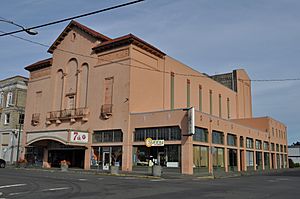
Yearly Events
Hoquiam hosts the Logger's Playday every September. This event includes a parade and a logging competition. Loggers from all over the world come to compete.
Other events in Hoquiam include:
- The Shorebird Festival
- Hoquiam's Riverfest
- The On Track Arts Festival
Sports in Hoquiam
The main sports team in Hoquiam is the Hoquiam High School Grizzlies. Their team colors are crimson and gray. In 2004, the boys' basketball team had a perfect season, winning all 28 games. They won the state 2A championship. They even beat a touring team from Australia, which was the only game the Australians lost on their tour.
In 2006, the Washington Interscholastic Activities Association (WIAA) changed rules for school sizes. This allowed Aberdeen High School to join the same league as Hoquiam. This brought back their old football rivalry. In 2006, they played their 100th game against each other. Hoquiam won the 101st meeting 20-6. Even though Aberdeen has won more games overall, the rivalry is still strong.
Hoquiam and Aberdeen High Schools also have a yearly "Food Ball" competition. This is a food drive in the fall to help local families who need food. Everyone wins in this competition because it helps the community.
Since 1981, Hoquiam High School has hosted a large running event. The Hoquiam Grizzly Alumni Cross Country Invitational happens every October. It brings together over 35 schools and 1,000 high school runners. Hoquiam also hosts a Grizzly Alumni Wrestling tournament in January and a Volleyball tournament in September.
The city was also home to the Grays Harbor Gulls baseball team from 1995 to 1997. They played at Olympic Stadium, which is a historic place. Today, Hoquiam is home to the Grays Harbor Bearcats, a developmental football team. In the past, the city had other baseball teams like the Hoquiam Loggers and the Grays Harbor Ports.
City Infrastructure
Flood Control Systems
Hoquiam has improved its flood control as part of the Chehalis Basin Strategy. In 2018, a new pump house was built for $1.3 million. This new station protects the northern part of the city, including Lincoln Elementary School. It's an important project for future flood walls, known as the North Shore Levee.
New pipes were also added to control floodwaters. These improvements are expected to help homeowners and businesses in the area avoid needing flood insurance in the future. During a flood in January 2022, the new station pumped 51 million gallons of water for 30 hours without stopping. These upgrades are expected to save the city a lot of money by preventing damage from floods.
Transportation Hubs
The local airport is Bowerman Airport (HQM). It's the only airport on the Washington coast that can handle jet planes. It has a 5,000-foot (1,524 meter) runway. The airport is on a narrow piece of land that goes into Grays Harbor. Many types of migratory birds also visit this area during the warmer months.
Notable People from Hoquiam
- Anton Anderson – An engineer who became Mayor of Anchorage, Alaska. He worked as a surveyor in Hoquiam.
- Thomas J. Autzen – A leader in making plywood.
- Eldon Bargewell – A U.S. Army general who commanded Delta Force.
- William Boeing – The aviator who started the Boeing company.
- Robert Cantwell – A writer and critic who lived in Hoquiam.
- Harris Ellsworth – A U.S. Congressman from Oregon.
- Jack Elway – A football player and coach.
- Ed Gayda – A basketball player drafted by the Tri-Cities Blackhawks in the NBA.
- George H. Hitchings – Won the Nobel Prize in Physiology or Medicine in 1988.
- Lynn Kessler – Served eight terms in the Washington State House of Representatives. She lives in Hoquiam.
- Albert Kuhn – A pioneer and businessman.
- Ida Soule Kuhn – A pioneer and activist.
- Walt Morey – An author.
- Howard P. Robertson – A mathematician and physicist known for his work on the universe.
- Martin F. Smith – A U.S. Representative from Washington who practiced law in Hoquiam.
See also
 In Spanish: Hoquiam (Washington) para niños
In Spanish: Hoquiam (Washington) para niños


